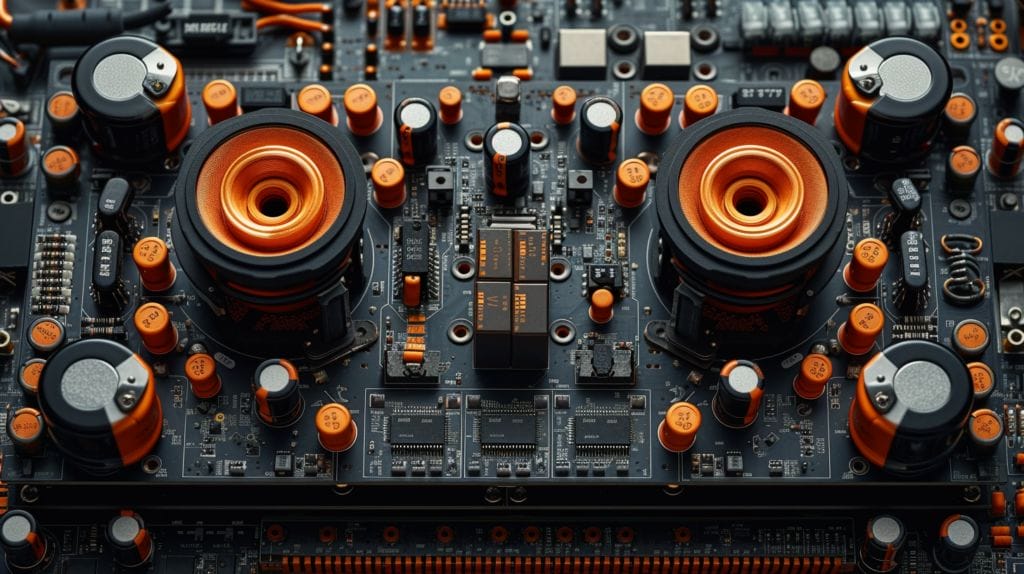Wire A Dual Voice Coil Sub: Mastering DVC Subwoofer Wiring
As a conductor leads a symphony to perfection, so we’re poised to guide you through the harmonious world of dual voice coil (DVC) subwoofer wiring. This isn’t just about twisting a few wires together for a subwoofer enclosure – there’s both an art and a science to it.
In our ‘Wire A Dual Voice Coil Sub’ guide, we’ll examine various wiring configurations for dual 4 ohm subwoofers, delve into total load and impedance calculations, and discuss how to correctly use speaker wire to connect these audio beasts to your amplifiers and receivers. You’ll discover how getting your hands dirty with DVC subwoofer wiring can open up entirely new levels of audio experience.
Key Takeaways
- Dual voice coil subwoofers offer superior flexibility and sound quality.
- Wiring options for dual voice coil You’ll discover how getting your hands dirty with DVC subwoofer wiring diagrams for two can open up entirely new levels of audio experience, particularly when wired in series or parallel.
- Different wiring configurations (series, parallel, combination) offer different advantages.
- Understanding total load and impedance helps optimize sound system performance.
Understanding the Basics of Dual Voice Coil Subwoofers

Delving into the world of audio systems, it’s essential to understand the basics of a dual voice coil subwoofer. These devices offer superior flexibility and sound quality. They have been game-changers in the audio industry, particularly due to their versatility and the enhanced sound quality they deliver.
A dual voice coil subwoofer consists of two voice coils wound on the same cylinder, connected to the cone. This unique structure allows for a variety of wiring options, opening up a plethora of possibilities for audio enthusiasts. You can wire a DVC sub in several ways, depending on your sound system’s requirements.
The flexibility extends to impedance options as well. A 4-ohm DVC subwoofer provides more wiring flexibility, suitable for users who may want to upgrade their system in the future. In contrast, a 2-ohm DVC subwoofer is ideal for maximizing amplifier power and delivering punchier bass.
Wiring Configurations for Dual Voice Coil Subwoofers

Understanding the different wiring configurations for svc and DVC subwoofers is crucial, as each setup can significantly impact your car audio experience. We’ll guide you through the most common wiring options: Series, Parallel, and Combination wiring.
- Series Wiring: This configuration involves connecting the coils sequentially. If you’re using a 4-ohm DVC subwoofer, series wiring will increase the overall impedance to 8 ohms. This setup is ideal if you’re aiming for a less power-demanding, more relaxed sound output.
- Parallel Wiring: Here, as seen by the amplifier, the coils are wired side by side, reducing total impedance. For instance, a 2-ohm DVC subwoofer will drop to 1 ohm in parallel wiring. This option gives you louder, more vibrant beats but requires more power from your amplifier.
- Combination Wiring: For multiple subwoofers, a combination of series and parallel wiring provides the most flexibility. This setup allows you to balance power demand and sound output to meet your specific needs.
Calculating Total Load and Impedance for Dual Voice Coil Subwoofers

Calculating the total load and impedance for DVC subwoofers might seem complex, but with a bit of understanding and practice, it becomes straightforward. The total load, for instance an 8 ohm load or a 2 ohm load, refers to the overall power that the subwoofer system can handle, and impedance is a measurement of the resistance to the flow of an electric current.
In a series wiring setup, the impedance for DVC subwoofers adds up. For instance, if each coil has an impedance of 4 ohms, the total impedance in a series setup would be 8 ohms – this ohm rating is important.
In a parallel configuration, the total impedance is divided by the number of coils. For example, when wiring a dual 4 ohm subwoofer in a parallel setup, the connection between the same 4-ohm coils would result in a total impedance of 2 ohms. This understanding is key to optimizing your sound system’s performance, ensuring that you’re not overloading or underpowering your system, which could result in poor sound quality or damage.
Wiring Dual Voice Coil Subwoofers to Amplifiers and Receivers

The goal of wiring DVC subwoofers to amplifiers and receivers is to ensure the subwoofer’s ohm load matches the output impedance of the amplifier, a key factor in maximizing performance and preventing equipment damage.
- First, identify the impedance of the DVC subwoofers and the amplifier’s output impedance. They should match or be within a safe range of each other.
- Next, wire the DVC sub to the amplifier, ensuring positive to positive and negative to negative connections.
- Finally, double-check connections for tightness and correct polarity before switching on the system.
Can I Apply the Same Wiring Techniques from a Light Switch to Wiring a Dual Voice Coil Subwoofer?
Yes, you can apply the same wiring techniques from wiring a 3 gang switch to wiring a dual voice coil subwoofer. Both require understanding how to connect multiple sources to a single output, making the principles of wiring transferable between the two applications.
Troubleshooting and Common Issues with Dual Voice Coil Subwoofers

Despite our best efforts, we might encounter common issues that need troubleshooting, particularly when dealing with impedance mismatches in dual voice coil speakers and their effects on performance.
Incorrect wiring can result in suboptimal sound quality or even damage to the subwoofers. A common mistake is wiring the voice coils in series when they should be in parallel, or vice versa. This not only affects power handling but also impacts overall sound quality.
Imbalance in power distribution is a common issue, especially in car audio systems involving svc subwoofers. If power isn’t evenly distributed across the terminals of the dual voice coil speakers, it can lead to sound distortion or inconsistency.
Overloading, leading to a blown subwoofer, often happens when the power output from the amplifier exceeds the power handling capacity of the ohm dual voice coil speakers. The key is to ensure the amp’s power doesn’t exceed the sub’s RMS rating.
Conclusion
We’ve walked you through the basics of wiring a dual voice coil sub, different configurations, and how to calculate total load and impedance.
We’ve also touched on how to wire them in series using the correct gauge wire in the process of creating a subwoofer enclosure. wiring them to amplifiers and receivers.
We hope this manual has cleared up any confusion you might’ve had about wiring single voice coil subwoofers.
But remember, if the coils are wired in series or parallel and you encounter any issues, don’t hesitate to refer back to our troubleshooting guide.
Wiring a DVC sub can be intricate, but with patience, it’s entirely manageable.
Frequently Asked Questions
What is a dual voice coil (DVC) subwoofer?
A DVC subwoofer has two separate voice coils, each with its own connections, allowing for more wiring options and flexibility in creating different impedance loads.
How do I wire a dual voice coil subwoofer?
You can wire a DVC subwoofer in parallel or series to achieve different impedance loads, depending on your requirements and the capabilities of your amplifier.
What are the advantages of a dual voice coil subwoofer?
DVC subwoofers offer more flexibility in wiring options, allowing you to match the impedance of your amplifier and maximize power output. They also provide the ability to wire in parallel for a lower impedance load or in series for a higher impedance load.
Can I wire a dual voice coil subwoofer to a 4-ohm or 2-ohm load?
Yes, you can wire a DVC subwoofer to a 4-ohm or 2-ohm load, depending on how you connect the voice coils and the wiring options shown in the available wiring diagrams.
What do I need to consider when wiring a dual voice coil subwoofer?
When wiring a DVC subwoofer, it’s important to consider the overall impedance load, ensuring it’s compatible with your amplifier and can handle the amount of power you intend to deliver.







